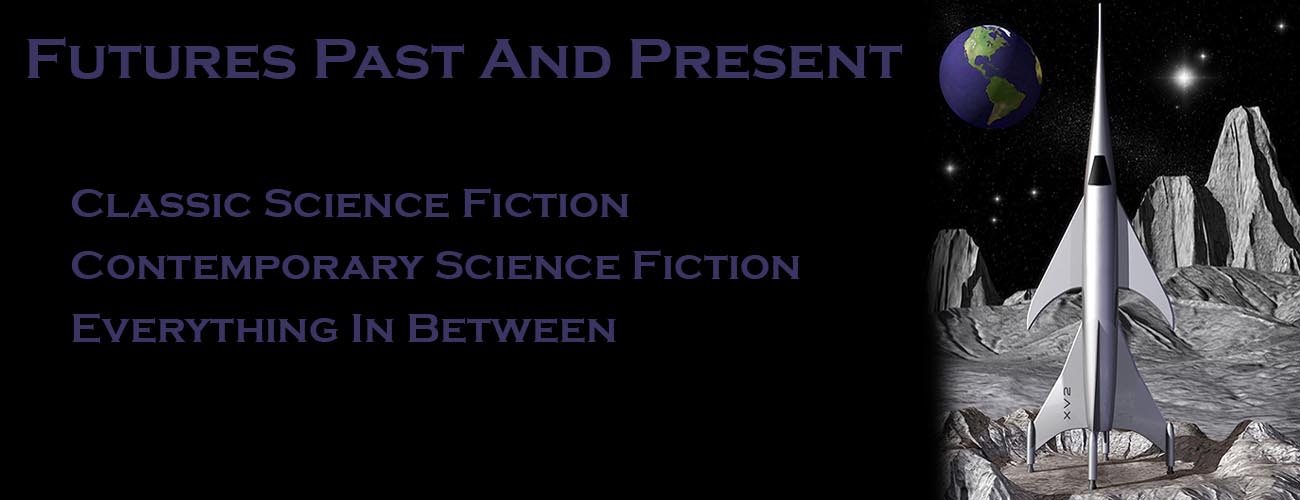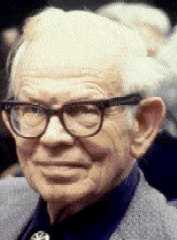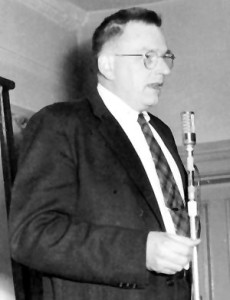Hal Clement, real name Harry Clement Stubbs, was born on this date, May 30, in 1922. He passed away in 2003. He attended Conestoga the last few years of his life, and I was privileged to meet him on those occasions. Once I was walking through the dealer’s room, and someone was following along behind me whistling. I turned around and saw that it was Hal Clement. Continue reading
Tag Archives: John W. Campbell Jr.
Piper’s “Omnilingual”
So as I was writing yesterday’s post on Raymond Z. Gallun and his story “Old Faithful”, I couldn’t help but think of H. Beam Piper’s “Omnilingual”. Both stories concern communication between Earth and Mars. Gallun dealt with two living species trying to find common ground for communication. Piper ups the ante by having a group of archaeologists, or rather one archaeologist in particular, try to find common ground and read the writings left behind by a long dead race.
After posting that review, I checked the ISFDB to see if there were any birthdays of note today. Lo and behold, whose name did I see but H. Beam Piper’s? Talk about good timing. (The universe made up for it this today.)
Henry Beam Piper was born on March 23, 1904. He has been forgotten by many readers, especially younger readers, and that’s a shame. He was one of the best writers the field produced in the middle of the last century. If he had lived longer (he died in 1964), perhaps he would be better known today.
Piper published most of his stories in Astounding, so this post also counts at a 90th Anniversary post for Astounding. “Omnilingual” first appeared in the February 1957 issue.
This review is going to contain spoilers. If you want to read the story first, it’s currently available in The Rise of the Terran Federation, edited by John F. Carr or in the H.Beam Piper Megapack, which contains some of his nonfiction. Continue reading
Being Faithful to Old Raymond Z. Gallun
Raymond Z. Gallun (rhymes with “balloon”; his family was Dutch) was born on this date, January 22, in 1911. Gallun passed away in 1994.)
This post is going to serve triple duty. First, it’s a birthday post. Second, it’s going to be a 90th Anniversary of Astounding post. Third, it’s also a pre-Campbell SF post.
Gallun is largely forgotten now, but he was pretty prolific from 1929 through the early fifties. If he is remembered at all, it’s for his story “Old Faithful”, which was first published in the December 1934 issue of Astounding. Continue reading
Astounding/Analog 90th Anniversary: F. Orlin Tremaine
Editor F. Orlin Tremaine was born on this date, January 7, 1899. He passed away at the age of 57 in 1956. Tremaine worked at the Clayton pulp company, although he had no editorial duties with Astounding. He left to pursue other publishing ventures which didn’t pan out and returned to Clayton in 1932. When Clayton went belly-up, Street and Smith bought the company. It was this time Tremaine was editing responsibilities for Astounding along with other titles. Tremaine edited Astounding from 1932 until late 1937, at which time he hired John W. Campbell, Jr to edit the magazine. Tremaine was promoted to Editorial Director.
Among the authors Tremaine published were H. P. Lovecraft (At the Mountains of Madness and The Shadow Out of Time), L. Sprague de Camp, Raymond Z. Gallun, Jack Williamson, Murray Leinster, and Eric Frank Russell. Oh, and some guy named Campbell.
Eric Frank Russell’s “Hobbyist”
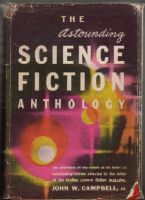 This is another post that’s going to do double duty as a birthday post and an Astounding anniversary post. It’s also going to be out of order in respect to the ToC.
This is another post that’s going to do double duty as a birthday post and an Astounding anniversary post. It’s also going to be out of order in respect to the ToC.
Eric Frank Russell was born on this date, January 6, in 1905. He passed away in 1978. Russell was British, and although he was well-known in the US during his lifetime, he has sadly slipped into obscurity these days. None of his short fiction is in print in electronic format in the US. Only the NESFA collection Major Ingredients is in print. His novels are doing a little better, with several being available in print and electronic formats. Continue reading
The Astounding Science Fiction Anthology, Part 1
 So, as part of Astounding/Analog’s 90th anniversary, I’m going to be reading through The Astounding Science Fiction Anthology over the few months. I’ll read one or two stories, and post on them here, mostly in order.
So, as part of Astounding/Analog’s 90th anniversary, I’m going to be reading through The Astounding Science Fiction Anthology over the few months. I’ll read one or two stories, and post on them here, mostly in order.
Edited by John W. Campbell, Jr., the anthology was first published in 1952 by Simon and Schuster. For more on the backstory behind the anthology, see this excellent post at Black Gate. The stories are presented in the book roughly in the order of publication, beginning with Heilein’s “Blowups Happen” from 1940 and ending with “Protected Species” by H. B. Fyfe, which was published in 1951. The complete table of contents is listed in the picture below. Click to enlarge. Continue reading
Astounding/Analog at 90
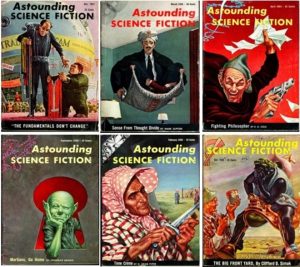 Next year will mark the 90th anniversary of Astounding Science Fiction, known these days as Analog. To mark the occasion, editor Trevor Quachri will be reprinting one story from each decade, starting with the 1940s and going through the 1990s. Anything later than the nineties, Quachri says, is too recent. More time will be needed to determine what the true classics will be. All right, I can go along with that, no problem.
Next year will mark the 90th anniversary of Astounding Science Fiction, known these days as Analog. To mark the occasion, editor Trevor Quachri will be reprinting one story from each decade, starting with the 1940s and going through the 1990s. Anything later than the nineties, Quachri says, is too recent. More time will be needed to determine what the true classics will be. All right, I can go along with that, no problem.
There will also be no stories reprinted from the 1930s. The reasoning here is that the identity hadn’t really formed yet. That sounds a lot like John Campbell hadn’t yet put his imprint on the magazine. Considering Quachri was in full support of changing the name of the Campbell Award earlier this year, I find this an interesting position to take. It’s his magazine, and he’s the editor, so I’m not going to make an issue of it. There are some writers from the Clayton days in the 30s who went on to have successful careers after Street & Smith took over the magazine, such as Clifford D. Simak, Jack Williamson, Edmond Hamilton, and Campbell himself. Continue reading
Frank Herbert vs. Isaac Asimov
Today (October 8) marks the birth of Frank Herbert (1920-1986). Herbert wrote a number of novels and short stories, but he will always be known as the author of Dune. Dune was originally serialized in Analog (formerly Astounding) starting in December 1963. It was published in book form in 1965. The original publisher was Chilton. You know, the one that does the auto manuals.
Dune is set in a galactic empire, which is of course ruled by an Emperor. Herbert wrote a number of sequels, and his son Brian has coauthored additional sequels and prequels with Kevin J. Anderson.
Herbert wasn’t the first, nor was he the last, to use a galactic empire in a work of science fiction. One of the most prominent people to do the same was Isaac Asimov (who also wasn’t the first). Asimov started his Foundation series in the pages of Astounding roughly two decades earlier. It’s interesting to note that John W. Campbell was the editor for the original appearances of both series. I’m not going to go there in this post, because that sounds like a Ph.D. dissertation in Literature.
While comparisons have been made between the Dune series and Gibbon’s Decline and Fall of the Roman Empire, Asimov intentionally patterned the Foundation stories after Gibbon’s work. Several novels were set in the same universe before the time of the Foundation. Asimov would later go on to write additional novels in the last decade of his life and tie the series in with his robot stories, both the short stories concerning Susan Calvin and the detective novels starring Elijah Bailey and R. Daneel Olivaw. There were also a few sequels coauthored and/or authored by other writers.
Both Asimov and Herbert have been dead for a number of years. The influence of these two works has been tremendous. If you go into any bookstore today, most of the books by Asimov will be from the Foundation series, and most of the books by Herbert will be from the Dune series. Few, if any, of the titles you find by these authors will be outside these series.
Dune seems to be the more popular of the two at the moment, in part because new Dune titles are regularly being published, and also because there’s another film in the works. Foundation seems to be languishing a bit in comparison.
I read all the Foundation books Asimov wrote, although not all the galactic empire novels and none of the sequels. I’ve only read the original Dune. Dune Messiah and Children of Dune are in the TBR pile. I intend to reread Dune later this year; I first read it about 15 years ago. I read the original Foundation Trilogy…much longer ago than that, like in high school.
So I’m toying with the idea of reading the first three Dune books and the original Foundation Trilogy. This will be over the next year or three. I’ve got some other things to get through first. It will be interesting to see how they have stood the test of time from when I was younger.
As for what prompted this idea, well, that’s the topic of an upcoming post.
The Pre-Campbell Science Fiction Challenge
It has been said that imitation is the sincerest form of flattery. With that in mind, I’m going to steal borrow an idea from Alexandru Constantin over at the Barbarian Book Club. His challenge was to read three fantasy short stories published before The Lord of the Rings changed the landscape of fantasy.
I’m going to apply that idea to science fiction.
There can be little argument that when John W. Campbell, Jr. became editor of Astounding Stories (which later became Astounding Science Fiction) in 1938, he changed the field of science fiction forever. Whether this was a good thing or a bad thing is certainly open to interpretation. The accepted narrative for years has been that this was a completely good thing. Campbell introduced scientific rigor and raised the literary standards by jettisoning many of the pulp tropes of mad scientists (usually with beautiful daughters for the hero to win) and scantily clad women being abducted by bug-eyed monsters.
Lately that narrative has been challenged. Some writers have claimed that this wasn’t a good thing at all. I’m not going to try to name them because I will invariably leave someone out and this isn’t intended to be a personal attack on anyone. A few have even gone so far as to say Campbell ruined science fiction.
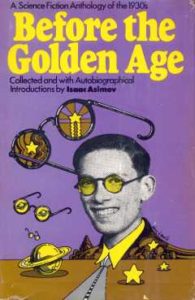 I’m not prepared to go that far. I happen to like Campbellian science fiction, just as I like Tolkienesque fantasy. I also happen to like science fiction from before Campbell, just as I like fantasy that predates Tolkien. Much of the science fiction from the previous century hasn’t aged well, but that can be said of any genre.
I’m not prepared to go that far. I happen to like Campbellian science fiction, just as I like Tolkienesque fantasy. I also happen to like science fiction from before Campbell, just as I like fantasy that predates Tolkien. Much of the science fiction from the previous century hasn’t aged well, but that can be said of any genre.
But I do think these folks have a point. Science fiction wasn’t the same after Campbell, and we lost some of the energy and thrill that went with it. Even Isaac Asimov, a Campbellian writer if there ever was one, admitted as much in his introduction to Before the Golden Age, his autobiographical anthology of pre-Campbellian science fiction.
With a tip of my space helmet to Alexandru Constantin, here’s what I’m proposing.
- Read three short stories that are clearly science fiction. The stories should be from before 1938, when Campbell took the reigns of Astounding.
- Post a review on your blog, telling us why these stories should still be read. Or not, as the case may be. And post a link here in the comments so we can find your review.
- You also need to tell us where you read them so anyone interested can track them down.
As I mentioned in my post at Adventures Fantastic last night, we’ve been told that the older stuff is racist, sexist, etc. The pronouncement has also been made the science fiction has always been progressive. I suggested a Schrodinger’s Cat explanation for how it can be both. Here’s a chance to see what early science fiction was really like.
So that’s your assignment, class. Get to it.
Kuttner’s Baldy Series: “The Lion and the Unicorn”
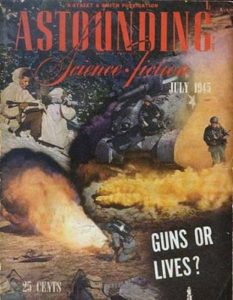 “The Lion and the Unicorn”
“The Lion and the Unicorn”
Originally published in Astounding Science Fiction, July 1945
This is the third installment of the Baldy series, written by Henry Kuttner and C. L. Moore under their joint pen name of Lewis Padgett. The reviews of the preceding two stories can be found here and here.
Spoilers to follow.
“The Lion and the Unicorn” opens only a few decades after “Three Blind Mice”. Barton, the protagonist of the previous tale, is still alive. He’s in his sixties, and while a key player, he’s not the central figure in this story. Barton managed to kill the Baldies who had developed the alternate wavelength, but there are others. It turns out the ability to send and receive telepathic messages on this alternate wavelength is a new mutation on the Baldy mutation. And all the Baldies who have it are paranoid. Continue reading
